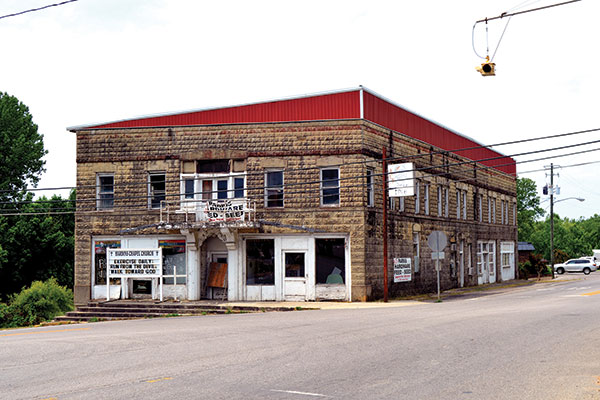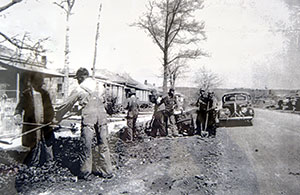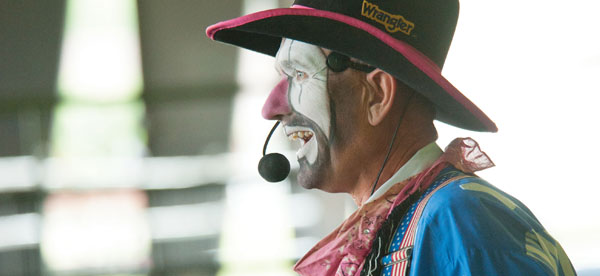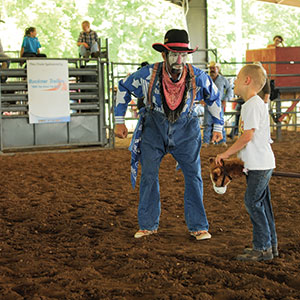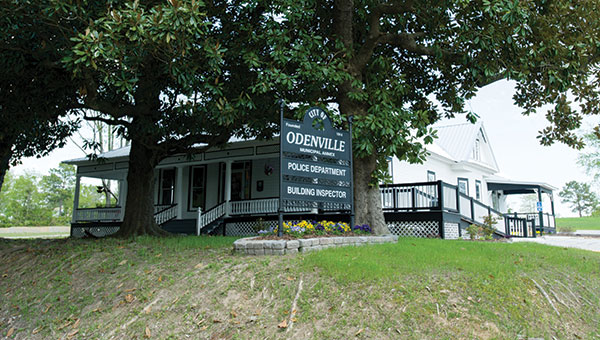
Growing community‘A place to call home’
Story by Paul South
Photos by Wallace Bromberg Jr.
There’s a story Joe Whitten likes to tell, a story that speaks far more loudly about Odenville than about himself.
In 1961, Whitten was a newly-recruited teacher to St. Clair County High School, a stranger in town. He’d been given a 10-month contract, paying $350 a month. And he was scared.
“I’d been in town for about three weeks, and parents of the kids were calling me and inviting me for an evening meal. I don’t remember exactly what was served, except it was good home-cooked food. But what I remember is that these people invited me into their lives and into their community. I’ll never forget that acceptance.”
Whitten, now 78, would go on to teach in Odenville for more than 35 years and write histories of Odenville and St. Clair County High. He still lives in town, on some nights, he’s lulled to sleep by the gentle rumble of the CSX train as it rolls slowly through town.
“God put me here,” he said. “I love it here. It’s wonderful.”
Stories like Whitten’s – of welcome and acceptance — are told over and over again by newcomers and lifelong residents to this town of less than 5,000, 3,585 according to the 2010 census. Even as the town has expanded out to Interstate 59, the heart of the town hasn’t changed.
Beginnings
Peter Hardin, a blacksmith and Presbyterian pastor, led the first band of settlers to what’s now Odenville in 1821, two years after Alabama was granted statehood. It was the first of several key historic milestones for the town once known as Hardin’s Shop. Odenville was incorporated in 1914, but no one is sure exactly how it got its name, Whitten said.
In 1903, the Seaboard Airline Railroad (now CSX) helped tie Odenville to Birmingham, Atlanta and the northeast. Not only that, but along with good-paying jobs and company-built homes, the railroad boosted local businesses. The Cahaba Hotel was one of them, offering room and board for travelers. The now-gone landmark once was a favorite of Odenville’s children, according to Odenville Library director Betty Corley.
“There was a candy store on the first floor of the hotel, “she said. “And kids used to love to go there to buy penny candy.”
Whitten recounted how townsfolk would gather near the tracks to wave at Miss Alabama each year, as she traveled northeast to Atlantic City, N.J., for the Miss America pageant.
Strictly freight rides the rails now through Odenville. But in its prime, the passenger line even provided transportation to school for rural St. Clair County schoolchildren to the St. Clair County High, which once housed grades 1-12 under one roof.
The high school and where it would be located sparked spirited debate between the editors of the newspapers of Odenville and Pell City. Whitten has written a history of the high school (Where the Saints Have Trod) and of Odenville (Odenville, Alabama: A History of Our Town,1821-1992).
“The editor of the Pell City paper (The Pell City Progress) wrote that he was afraid the state would regret “ ‘putting a $10,000 school in a thousand-dollar town.’ ” And the editor of the Odenville paper countered that Pell City was fine for a mill town, but not for a school. It was something,” Whitten said.
Odenville won the school, and St. Clair County High remains to this day. The original school opened in 1909. Today, a state-of-the-art high school has replaced it.
And while the trains no longer haul passengers, they carry a multitude of memories for Odenville residents like Jimmy Bailey, Odenville’s Mayor Pro Tempore and the manager of Odenville’s water system, the county’s largest water utility. Bailey’s father was a conductor on the Seaboard Airline train that ran through Odenville. Bailey often rode with his dad to Atlanta and back in a day.
Among his treasures are his Dad’s uniform, his briefcase and a timetable.
“I’ve always loved trains. What stood out to me was the Atlanta Terminal Station. They had a big model railroad set up there,” Bailey said.
But while the passenger trains are gone, more people – and businesses – would come to Odenville and St. Clair County.
An expanding footprint
If a key word could describe Odenville’s growth, annexation springs to mind. In 2007, the town of Branchville merged with Odenville after a landslide approval. A subsequent annexation has expanded Odenville’s footprint to the Springville/Odenville exit on Interstate 59. Four new businesses have already located there. The town is hopeful for more, city leaders say, and there is a daily drive to recruit new businesses. The city has developed a reputation that may lead to success.
“Odenville is the most business-friendly city in the county,” said longtime real estate executive and developer Lyman Lovejoy. “They are out recruiting every day.”
Evidence of Odenville’s growing footprint is Legacy Park, an approximately 250-acre mixed use development near I-59. Four businesses are already open at the site. A Foodland Plus grocery store is also on board for the multi-million-dollar project, according to Greg Bratcher, building inspector and revenue officer for the City of Odenville.
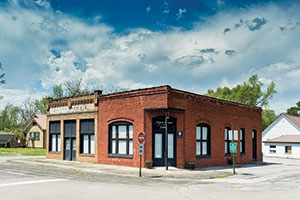 On the residential side, an apartment complex with an estimated 242 units is planned for the site.
On the residential side, an apartment complex with an estimated 242 units is planned for the site.
“As this site is developed, this will provide extra funds for the surrounding communities, employing hundreds of people, which will have a large impact for Odenville, Springville and St. Clair County, Bratcher said.
The anticipated economic bounce is also expected to provide more money for police and fire protection, Bratcher said. And the City of Odenville has purchased a 65-acre tract in the community to provide a multi-purpose park.
Like many of its neighboring communities, Odenville wrestles with managing growth, while preserving the history and character of the city. It’s a delicate waltz of preservation and progress.
Traffic is a problem, particularly during school hours. But on the other side of the coin, the town has invested in preserving historic buildings, like the old Odenville Bank building and city hall, where the “Sis” Fortson Museum and Archives now resides. The town also converted one of Odenville’s historic homes into the police station and is working on other preservation projects.
Pride is the driving force behind the preservation of the past in Odenville, Mayor Rodney “Buck” Christian said. The city is “full of public servants,” committed to making their town better.
“They’re proud of their history and where they came from, and hopefully they’re encouraged about where we are headed in the future,” he said. “There are people in our community who would prefer no growth, I’m sure. But it’s coming our way, whether we like it or not. How you manage and accept that growth is critical.”
The reality of growth is evident in developments like Legacy Springs, where hundreds of homes have already been built. But there is hope for more restaurants, motels and other businesses, to meet the needs of the citizens. But Christian makes it clear, the heart of Odenville has to be preserved.
Asked his vision for the town moving forward, Christian said, “Obviously we want more economic development, a stronger revenue stream and an improved road system, but at the same time maintaining our identity as a small, close-knit, family-oriented, Christian community.”
Bailey agrees. He’s witnessed the demands of residential growth firsthand as manager of the water system. Now with 7,300 customers, the board also sells water to the Cook Springs Water Authority, the City of Margaret and the Northwest St. Clair Water Authority. In the early 21st century, he said, residential development took off. He points to 2006, where there were some 20 subdivisions under construction within the water system, a good bit of that construction within Odenville.
To put the growth of Odenville’s water system in perspective, when Bailey began as the system’s only full-time employee –aside from office staff—in 1979, the utility had 550 customers. Now with more than 7,000 customers, the system will begin selling water to Rainbow City in November of this year, Bailey said.
“Fortunately, we have always had a board composed of members that wanted to see the system grow and provide water service to those that needed it,” Bailey said. “Also, the growth (of the utility) enabled the creation and development of local jobs, which was a priority for me and the board.
As growth continues, Bailey believes “smart growth” is critical.
“That is a big part of it,” Bailey said. “Upgrading infrastructure is a constant thing. Most of the growth is residential. There’s a small amount of commercial growth that has come with it. One of the challenges that we face is that the residential growth outruns the commercial growth. People who move here expect services and amenities that are in larger towns, and we still don’t have the tax base to provide. We’re constantly encouraging new businesses and commercial development to increase our tax base.”
The heart of the city
But beyond tax bases and infrastructure, the heart of a city is its people. Talk to enough Odenville residents and their stories sound a lot like Joe Whitten’s. The people are in love with the town and deeply care about each other.
Trese Mashburn has lived in Odenville for 15 years after marrying her husband Marlin, an Odenville native whose family owned the Cahaba Hotel. She wears a lot of hats – Odenville columnist for the St. Clair County News-Aegis, account representative for a local radio station, 94.1-FM, The River, and she was the creator of the Odenville Area Business Association, a business networking group that on most Mondays, draws 50 business representatives.
She also directs the city’s Christmas parade and in the past has been involved in charitable efforts and two music festivals in Odenville.
The Birmingham native calls her adopted hometown, “a little slice of heaven.”
“It doesn’t have a big bang as far as big business, but we have what we need,” she said. “It’s close-knit and wonderful.”
What makes Odenville special?
“To me what makes it unique and special are the people. Everybody there, even if you’re a transplant like myself, once you’re part of the community, you’re part of the community,” Mashburn said. Everyone there is so helpful and thoughtful and looking out for each other. Anytime there’s a person in need, we pull together and help those people.”
Lifelong St. Clair resident Joanie Mardis knows personally how the town pulls together. She and her husband Bruce operate Seasons of Adventure Travel, a full-service travel agency they operate in a home passed down from her grandparents.
While to folks in big cities, a travel agency in a town of less than 5,000 may fly in the face of conventional wisdom, Seasons of Adventure has flourished since opening in 2010, with customers in St. Clair County, throughout Alabama and in other states.
“The house that was in the front yard was probably 75-80 years old, but it burned when my dad was a little boy,” Joanie Mardis said “They had an old-fashioned barn raising and everybody came and built my grandparents’ house. They were without anything. Everyone worked together to help everyone else.”
The same has happened for Seasons of Adventure. Odenville and surrounding communities have supported the Mardis’ efforts.
“People might think that people in small towns don’t travel,” Joanie Mardis said. “But let me tell you, they travel.”
Dr. Mike Hobbs had never traveled more than 30 miles from his home in the rough-and-tumble Ensley neighborhood on Birmingham’s west side. Burglar bars on the windows and doors were common. While a student at Jefferson State Community College, he befriended an Odenville native, Shain (cq) Wilson. The two became fast friends and encouraged each other through school and remain friends to this day.
Hobbs remembers the first time he visited Wilson’s home.
“I was like, ’Wow, this is almost to Atlanta,’” he said with a laugh. There were no burglar bars. In fact, Wilson told him, there were some nights folks didn’t lock their doors.
Fast forward a few years. While a student at UAB, Hobbs met a St. Clair County girl. The two dated and eventually married. Bachelor’s, masters and doctoral degrees later, and the Hobbs family has settled in Odenville, where there are no burglar bars. In fact, the only additions to the doors and windows are Christmas lights in December. Hobbs may be Odenville’s Clark Griswold of Christmas Vacation movie fame.
Hobbs, dean of enrollment at Jeff State for the past 18 years, loves Odenville.
“I knew this was the place for us,” Hobbs said. “Everybody just welcomed us here like we’d been here our whole lives.”
‘A Place to Call Home’
In Odenville, there’s a Hall of Heroes, honoring all of the city’s men and women who served in our nation’s military. There is a fragile, 1652 volume of John Milton in Latin in the library. The family of comedian Pat Buttram lived here, as did the Western writer Ralph Compton. Football stars Dee Ford of Auburn and the Kansas City Chiefs and former Jacksonville State standout and NFL player James Shaw call Odenville home.
But what you hear about most in Odenville is love and kindness and family. And you hear about memories, of bluegrass being played years ago at an old blacksmith shop, or students and parents leading a new teacher around town, schooling him on the history of his new community.
Historian and retired educator Joe Whitten – the new teacher back in 1961 — probably described Odenville best.
“It’s a place to call home.”















